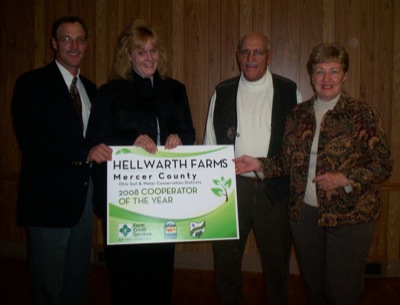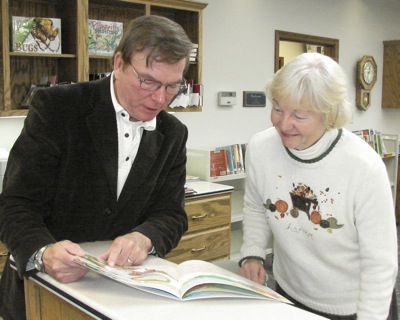Friday, November 14th, 2008
Area farmers urged to keep wind-energy profits local
By Janie Southard
CHICKASAW - An Ohio Farmers Union representative - speaking locally Thursday night - encourages local farmers to form do-it-yourself groups to invest in wind turbines to keep the profits in the community.
"This part of the state is proven to be very good for wind," John Ellerman of the state union told a group of 60 or so farmers at a public meeting held at a church in Chickasaw.
The meeting was hosted by the Mercer County Farmers Union. Several public meetings have been held in the local area in recent months to entice local residents to place their land under contract as possible sites for wind turbines.
Ellerman said it's a four-year process to get a wind turbine up and running. It's not a small investment; the profit potential is also not small, he said.
"But, so far, Ohio is lagging behind in wind energy. Iowa is big ... and has tremendous state support for such projects. It and Minnesota have the most projects with Illinois coming along. The coal industry in Ohio is big so there is some resistance because of that."
He spoke at length about Community-Based Energy Development (C-BED) for which qualified owners include: individuals in the jurisdiction, nonprofit organizations, cooperatives, local government such as school districts, towns, cities, associations, etc.
"Wind farms must have at least 10 turbines to be competitive in the market ... A farm needs at least 1,000 acres minimum. You'll need 10 acres for one turbine and 150 acres for two. That's because of spacing," Ellerman said.
Later he pointed out a substation is needed for every seven turbines.
He provided some stats in response to questions from the floor: wingspread of the blades, which weigh seven tons each, is 129 feet. The rotor weighs 37 tons, turns at 15 revolutions per minute (rpm) and averages 29 mph. The tower is 260-feet tall, weighs 130 tons and spans a 13-foot-6-inch diameter on a foundation 30-feet deep.
"But you can farm right up to the tower, although you will need to establish service roads," he said.
The average efficiency is 30-40 percent because the 29-mph wind speed average cannot always be maintained.
In response to one person's question, Ellerman said the newer turbines are programmed to shut down in high winds, somewhere above 40 mph.
"What makes this area so good is the Class 4 winds and on some ridges Class 5. It's the higher the better with a minimum of Class 3, which is all (the Bowling Green wind field) averages," he said, referring to a color-coded area graph.
A Class 4 wind, for example, is equals to an average wind speed of 16.8 mph.
In response to the big question of what it takes to get a turbine in the air, Ellerman outlined the three- to four-year lead time.
The first year is spent gathering the test tower results, he said.
"I think the towers already in place in your area could help you out including the one Crown Corporation will install in December. Cost to build a test tower is about $25,000 but you could purchase results for about $250," Ellerman said.
The second year is for financing and obtaining permits. Test results will play a big part in both these areas, he said.
The third year is for installation. During the installation process it's wise to band together on hiring a crane at an estimated cost of $250,000 just to get it here, he said. There are currently only five in the nation large enough for this work, he added.
"You can count on an average cost of $2 million per megawatt. But there are grants and subsidies available and not too difficult to get. Also, for a fee, you can hire an experienced company to do all this initial work for you," the Wisconsin native said. "Without grants, payback on a smaller turbine (2 megawatts) is about 20 years."
He urged the group to consider the number of area municipal power companies who present a prime market as well as getting on the national power grid.
"Your profit depends on selling the energy, and with all these munis around you, I'd suggest you back up to one of those," he said, estimating an average annual revenue of $1.4 million per 2.3 megawatt unit, depending on the price negotiated.
"This is a very good area. It's easy to see why you've got big companies knocking on your doors ... You have a lot to consider before you sign up with anyone. You should link up with a professional developer for information before you sign on the dotted line with a big company," he said.


